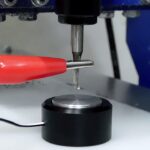
Absolute probes generally have a single test coil that is used to generate the eddy currents and sense changes in the eddy current field. As discussed in the physics section, AC is passed through the coil and this sets up an expanding and collapsing magnetic field in and around the coil. When the probe is positioned next to a conductive material, the changing magnetic field generates eddy currents within the material. The generation of the eddy currents take energy from the coil and this appears as an increase in the electrical resistance of the coil. The eddy currents generate their own magnetic field that opposes the magnetic field of the coil and this changes the inductive reactance of the coil. By measuring the absolute change in impedance of the test coil, much information can be gained about the test material.
Absolute coils can be used for flaw detection, conductivity measurements, liftoff measurements and thickness measurements. They are widely used due to their versatility. Since absolute probes are sensitive to things such as conductivity, permeability liftoff and temperature, steps must be taken to minimize these variables when they are not important to the inspection being performed. It is very common for commercially available absolute probes to have a fixed “air loaded” reference coil that compensates for ambient temperature variations.
Differential Probes
Differential probes have two active coils usually wound in opposition, although they could be wound in addition with similar results. When the two coils are over a flaw-free area of test sample, there is no differential signal developed between the coils since they are both inspecting identical material. However, when one coil is over a defect and the other is over good material, a differential signal is produced. They have the advantage of being very sensitive to defects yet relatively insensitive to slowly varying properties such as gradual dimensional or temperature variations. Probe wobble signals are also reduced with this probe type. There are also disadvantages to using differential probes. Most notably, the signals may be difficult to interpret. For example, if a flaw is longer than the spacing between the two coils, only the leading and trailing edges will be detected due to signal cancellation when both coils sense the flaw equally.
Reflection Probes
Reflection probes have two coils similar to a differential probe, but one coil is used to excite the eddy currents and the other is used to sense changes in the test material. Probes of this arrangement are often referred to as driver/pickup probes. The advantage of reflection probes is that the driver and pickup coils can be separately optimized for their intended purpose. The driver coil can be made so as to produce a strong and uniform flux field in the vicinity of the pickup coil, while the pickup coil can be made very small so that it will be sensitive to very small defects.

Some absolute and differential “transformer” type eddy current probes.
The through-transmission method is sometimes used when complete penetration of plates and tube walls is required.
Hybrid Probes

An example of a hybrid probe is the split D, differential probe shown to the right. This probe has a driver coil that surrounds two D shaped sensing coils. It operates in the reflection mode but additionally, its sensing coils operate in the differential mode. This type of probe is very sensitive to surface cracks. Another example of a hybrid probe is one that uses a conventional coil to generate eddy currents in the material but then uses a different type of sensor to detect changes on the surface and within the test material. An example of a hybrid probe is one that uses a Hall effect sensor to detect changes in the magnetic flux leaking from the test surface. Hybrid probes are usually specially designed for a specific inspection application.


